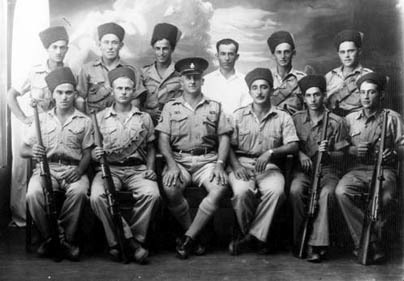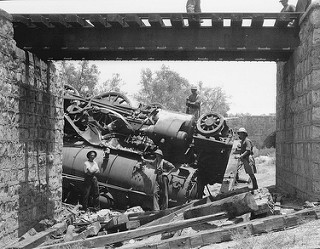Pages in Section 6

The Creation of the Notrim
ii. The Arab Rebellion- Strikes, Ambushes and Chaos
ii. Creation of the Notrim
iii. Next Section
 The British set up and trained The Notrim, a legal Jewish paramilitary Police Force, to help defend Jewish lives and property, especially in the settlements. (see photo on right) Members were recruited almost entirely from Haganah. In 1937, Notrim was given permission to expand, due to lack of British manpower and became an official part of the Palestine Police Force although most members syill nelonged to and were traine by Haganna. The force was divided into Supernumerary Police and mobile Settlement Police.
The British set up and trained The Notrim, a legal Jewish paramilitary Police Force, to help defend Jewish lives and property, especially in the settlements. (see photo on right) Members were recruited almost entirely from Haganah. In 1937, Notrim was given permission to expand, due to lack of British manpower and became an official part of the Palestine Police Force although most members syill nelonged to and were traine by Haganna. The force was divided into Supernumerary Police and mobile Settlement Police.
The government supplied the Notrim with Greener guns useless for long distance warfare. Since it sometimes took the British several days to come to the aid of a settlement, Haganah acquired up to date arms to replace Greeners in event of an emergency. The Notrim hid these from the authorities because, when military courts were established in November, 1937 the penalty for possessing illegal weapons was upped to the death penalty.

In 1938, because the Arabs were so successfully derailing trains, as well as sniping at them from stone walls, a regiment of the Notrim was formed to protect Palestinian railways/ It was given the title Palestine Police Railway Department (PPRD) anf consisted of over 700 Jewish policemen who underwent special training in Haganah.
The first line the new guard protected ran from Lydda to Haifa. Later other lines were integrated into the scheme. These included the Jezreel Valley line and the Jerusalem to Lydda line. The railway policemen erected watchtowers and conducted frequent patrols in search of guerillas. The Ford Motor Company built two designated armored train cars, which could move faster than conventional trains, and in both directions. The Railway Guard sometimes took with them prominent Arab leaders on the patrols, in order to insure that Arab gangs did not harm the police . As a child I saw one of those vehicles, with Palestine Police on board, operated by Arab prisoners pulling levers. In the centre an Arab effendi sat on a chair with his arms tied behind his back. The sight had a profound effect on me as a child.*
The Railway Guard's success prompted their stationing in other strategic locations, such as the Haifa Port. They continued serving in that capacity even during World War II, The British authorities maintained, financed and armed the Notrim until the end of the Mandate, despite realizing that, although the units were nominally answerable to the Palestine Police Force, they were, in fact, controlled by Haganah. During World War II, the Notrim became part of the Jewish Brigade, and later became the core of the Israeli Military Police.
The organization of the Notrim meant that except in Urban areas, the British section of the Palestine Police were more likely to work with Arab colleagues than Jewish ones